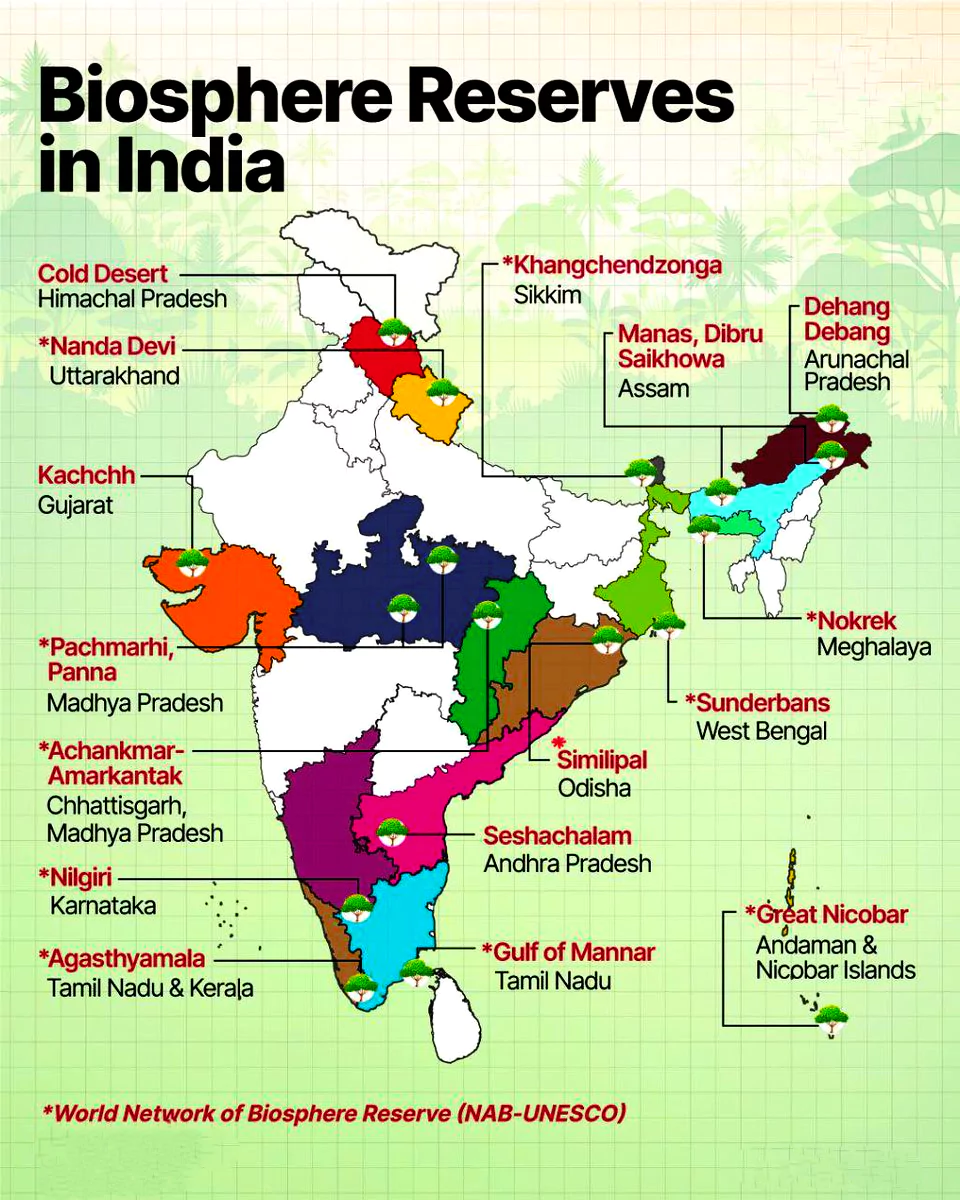Recently, the UN Educational, Scientific and Cultural Organization (UNESCO) has designated 11 new biosphere reserves, recognising their importance for conserving biodiversity and cultural heritage.
- There are about 275 million people living in biosphere reserves worldwide. The Network covers all major representative natural and semi-natural ecosystems.
About the New Designated Biosphere Reserves
The new reserves bring the World Network of Biosphere Reserves up to 759 sites in 136 countries and cover a total of 7,442,000 square kilometers (about 2,870,000 square miles), almost the size of Australia.
- Location: The new designations are in Colombia, the Dominican Republic, Gambia, Italy, Mongolia, Philippines, the Republic of Korea and Spain.
- Uniqueness: For the first time, the list includes two transboundary reserves, spanning Belgium and the Netherlands, and Italy and Slovenia.
- Significance: At a time when the international community is being called upon to increase the number of protected areas, these new biosphere reserves play an essential role in sustainably preserving biodiversity, improving the living conditions of local populations and indigenous peoples and fostering scientific research.
- It is emphasized that these designations come at a time when humanity is “grappling with a biodiversity crisis and climate disruption”.
Enroll now for UPSC Online Classes
About Biosphere Reserves
Biosphere Reserves is an international designation by UNESCO for representative parts of natural and cultural landscapes extending over a large area of terrestrial or coastal/marine ecosystems or a combination of both.

- Objective: To conserve biodiversity and to preserve the economic and social development and maintenance of associated cultural values.
- Nomination: Biosphere reserves are nominated by national governments and remain under the sovereign jurisdiction of the States where they are located.
- Designation: They are designated by UNESCO following an intergovernmental designation process under the Man and Biodiversity (MAB) Programme.
- Criteria For Designating a Biosphere Reserve:
- A Site with a Safeguarded Core Area: A site must contain a protected and minimally disturbed core area of value of nature conservation.
- Ecological Viability: The core area must be a bio-geographical unit and should be large enough to sustain a viable population representing all trophic levels.
- Community Involvement: The involvement of local communities and use of their knowledge in biodiversity preservation.
- Preserving Cultural Practices and Environmental Harmony: Recognizing the potential for preserving traditional tribal or rural modes of living, the area seeks to foster a harmonious coexistence with the environment.
- Three Levels of Biosphere Reserves:
- Core Zone: Strictly protected zone, providing habitat for flora and fauna, and protecting water, soil, air, and biota as a whole ecosystem.
- Buffer Zone: Surrounding the core zone, where people live and work in harmony with nature and functions as a laboratory for scientists to study nature, and for training and education.
- Transition Zone: The outermost zone, the place where communities practice socio-culturally and ecologically sustainable human activities.
- Importance: They are special environments for both people and nature and are living examples of how human beings and nature can co-exist while respecting each others’ needs.
- Important Scientific Roles: UNESCO highlighted that they play an important scientific role, serving as a site for research and monitoring, providing valuable data and insights that can inform environmental management and policy decisions.
- For Development and Protection: They help in achieving global development targets such as those set by the Kunming-Montreal Global Biodiversity Framework, inter alia, on protecting and restoring significant portions of the Earth’s ecosystems by 2030.
- Safeguard Biodiversity and Climate Change: They also promote unique local sustainable development ideas, safeguard biodiversity, and combat climate change.
Check Out UPSC NCERT Textbooks From PW Store
About United Nations Educational, Scientific and Cultural Organization (UNESCO)
It is a United Nations Specialized Agency founded in 1945 as the successor to the League of Nations’ International Committee on Intellectual Cooperation
- Aim: To contribute to peace and security by promoting international cooperation in education, sciences, culture, communication and information.
- Members: 194 member states including India and 12 associate members
- Membership of the United Nations carries with it the right to membership of UNESCO: Israel, Liechtenstein, are not member states of UNESCO
- Headquarters: Paris
- Reports: UN World Water Development report and Global Education Monitoring Report
- India and UNESCO: India has 42 sites in the World heritage site list with the most recent additions being Sacred ensembles of Hoysalas in 2023.
- The first Biosphere Reserve in India is the Nilgiri Biosphere Reserve that is a part of Tamil Nadu, Karnataka and Kerala.
About Man and Biosphere (MAB)
MAB is an intergovernmental scientific program, launched in 1971 by UNESCO, that aims to establish a scientific basis for the improvement of relationships between people and their environments.
- Importance: MAB combines natural and social sciences, economics and education to improve human livelihoods and the equitable sharing of benefits, and to safeguard natural and managed ecosystems, thus promoting innovative approaches to economic development that are socially and culturally appropriate, and environmentally sustainable.
|
![]() 9 Jul 2024
9 Jul 2024

